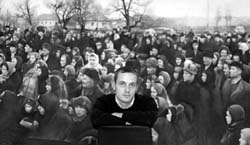Ukrainian Canadian artist’s color and black-and-white dreams

Can one be a citizen of one country and harbor a strong genetic affinity for another one, the land of one’s forefathers, where one’s own history actually began? Oleksandr Vlasenko is and does just that. He is a 31-year-old Ukrainian Canadian, born in Canada, and a very interesting artist. His exhibits are held in Canada, the United States, Italy, and now in Ukraine. He learned classical painting in Italy and Canada, but then decided to use his own technique which he calls pigment on paper.
This technique allows him to convey the warmth of his hands to every picture and the viewer to visit the artist’s black-and-white dreams about the past of his historical homeland. He creates his works, using the index finger and special powder resembling ground lead. His pictures look like old photographs; one sees cracks, dots, and fuzzy edges. Through the veil of time the viewer, together with the artist, seems to touch his past, trying to perceive it anew. Taking a closer look at the peasants gathered for the ceremony of unveiling a monument to their celebrated fellow countryman Mykola Lysenko (Vil. Hrynky, Poltava oblast, 1957), you wonder at the depressed air about them; no one seems happy. It is a huge canvas with 263 characters, based on a scene from a documentary. The camera is actually panning, yet the artist has masterfully captured the moment, conveying the scope and singular meaning of the scene. It is his latest work and Vlasenko did not display it in Canada. He wanted it shown first in Ukraine.
Oleksandr Vlasenko has visited Ukraine three times. His first visit in 1991 turned out symbolic. He arrived in Ukraine still under the Soviets and then left a country already taking the first steps on the path of national independence. Today’s Ukraine strongly attracts the artist. He has gone on sightseeing tours of various parts of it, noting that young people are free to use Ukrainian in the province as well as at the capital, that people feel uninhibited, remain very friendly and hospitable, and that the living standard has noticeably increased. During his previous visit Vlasenko saw no one in the street with a mobile phone. This time people with such phones are a common feature of urban life. He points out, however, that such gains of modern civilization have left Ukrainians rather traditional in daily life, and that here people are even more superstitious than in Canada. Also, strong will is obviously a Ukrainian trait. After communicating with young people, Oleksandr Vlasenko says that these people know exactly what they want and are remarkably determined to achieve it, adding, “I visit Ukraine every time to temper my character. Then I return to Canada and feel stronger, and it’s much easier to solve problems.”
He does not lose contact with Ukraine even when far away. He is a regular visitor to The Day’s web site. He is fond of Lina Kostenko, and he has put together a glossary with words he does not quite understand, using her verse, so he can have them explained in detail when visiting Ukraine. He has traveled far and wide and says that Ukraine is still little known elsewhere in the world, except perhaps for Cossack billowing trousers, borscht, and pyrohy. For him, Ukraine is embodied in outstanding works of art of the past and present. He believes that we should make our presence in the world more obvious, not so much politically as with our prominent personalities and achievements in science and the arts. He is convinced that this will eventually make Ukraine famous.






